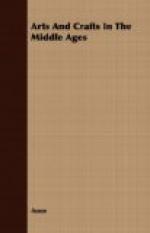Directions are given by Theophilus for the workroom, the benches at which the smiths are to sit, and also the most minute technical recipes for “instruments for sculping,” for scraping, filing, and so forth, until the workshop should be fitted with all necessary tools. In those days, artists began at the very beginning. There were no “Windsor and Newtons,” no nice makers of dividers and T-squares, to whom one could apply; all implements must be constructed by the man who contemplated using them.
We will see how Theophilus proceeds, after he has his tools in readiness, to construct a chalice. First, he puts the silver in a crucible, and when it has become fluid, he turns it into a mould in which there is wax (this is evidently the “cire perdu” process familiar to casters of every age), and then he says, “If by some negligence it should happen that the melted silver be not whole, cast it again until it is whole.” This process of casting would apply equally to all metals.
Theophilus instructs his craftsman how to make the handles of the chalice as follows: “Take wax, form handles with it, and grave upon them dragons or animals or birds, or leaves—in whatever manner you may wish. But on the top of each handle place a little wax, round like a slender candle, half a finger in length,... this wax is called the funnel.... Then take some clay and cover carefully the handle, so that the hollows of the sculpture may be filled up.... Afterwards place these moulds near the coals, that when they have become warm you may pour out the wax. Which being turned out, melt the silver,... and cast into the same place whence you poured out the wax. And when they have become cold remove the clay.” The solid silver handles are found inside, one hardly need say.




